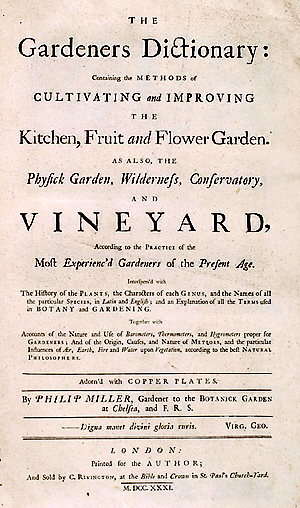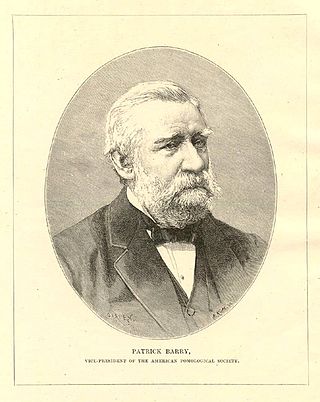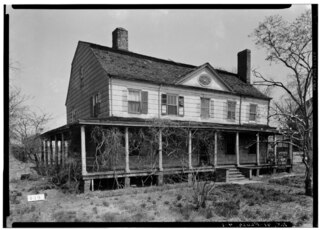
Flushing is a neighborhood in the north-central portion of the New York City borough of Queens. The neighborhood is the fourth-largest central business district in New York City. Downtown Flushing is a major commercial and retail area, and the intersection of Main Street and Roosevelt Avenue at its core is the third-busiest in New York City, behind Times Square and Herald Square.

John Bartram was an American botanist, horticulturist, and explorer, based in Philadelphia, Pennsylvania, for most of his career. Swedish botanist and taxonomist Carl Linnaeus said he was the "greatest natural botanist in the world." Bartram corresponded with and shared North American plants and seeds with a variety of scientists in England and Europe.

Philip Miller FRS was an English botanist and gardener of Scottish descent. Miller was chief gardener at the Chelsea Physic Garden for nearly 50 years from 1722, and wrote the highly popular The Gardeners Dictionary.

Ulmus rubra, the slippery elm, is a species of elm native to eastern North America. Other common names include red elm, gray elm, soft elm, moose elm, and Indian elm.

Queens Botanical Garden is a botanical garden located at 43-50 Main Street in Flushing, Queens, New York City. The 39-acre (16 ha) site features rose, bee, herb, wedding, and perennial gardens; an arboretum; an art gallery; and a LEED-certified Visitor & Administration Building. Queens Botanical Garden is located on property owned by the City of New York, and is funded from several public and private sources. It is operated by Queens Botanical Garden Society, Inc.

Kissena Park is a 235-acre (95 ha) park located in the neighborhood of Flushing in Queens, New York City. It is located along the subterranean Kissena Creek, which flows into the Flushing River. It is bordered on the west by Kissena Boulevard; on the north by Rose, Oak, Underhill, and Lithonia Avenues; on the east by Fresh Meadow Lane; and on the south by Booth Memorial Avenue. The park contains the city's only remaining velodrome, a lake of the same name, two war memorials, and various playgrounds and sports fields.

Patrick Barry, was a pioneer horticulturist, owner of the then-largest nursery in the United States, and noted author on the subject of horticulture.
The Wych Elm cultivar Ulmus glabra 'Corylifolia Purpurea' was raised from seed of 'Purpurea' and described as U. campestris corylifolia purpurea by Pynaert in 1879. An U. campestris corylifolia purpurea was distributed by the Späth nursery of Berlin in the late 19th and early 20th centuries. The Hesse Nursery of Weener, Germany, corrected the U. campestris corylifolia purpurea of their 1930s' lists to U. glabraHuds.corylifolia purpurea by the 1950s. Green listed 'Corylifolia Purpurea' as a form of U. glabra.
The hybrid elm cultivar Ulmus × hollandica 'Modiolina', or Wheel-hub elm, was probably the large-leaved 'Orme tortillard' first described by Duhamel in De l'exploitation des bois (1764). Poederlé (1774) identified the tree as the 'orme maigre' growing in the region that later became part of Belgium. Dumont de Courset described a small-leaved U. campestris var. modiolina, "l'orme tortillard" in 1802 – the first use of the name 'Modiolina'. 'L'orme Tortillard', also known as 'l'orme à moyeux', was considered in France to be the best elm for use by wheelwrights, its timber especially suitable for hubs of wheels. Van Houtte marketed an U. campestris modiolina (tortuosa), and Späth an U. campestris modiolina, from the late 19th century. U. campestris var. modiolinaHort was confirmed as a hybrid by Chevalier in Les Ormes de France (1942) and called U. × 'Modiolina', 'l'orme à moyeux'.
The Brooklyn–Queens Greenway is a bicycling and pedestrian path connecting parks and roads in the New York City boroughs of Brooklyn and Queens, connecting Coney Island in the south to Fort Totten in the north, on Long Island Sound. The route connects major sites in the two boroughs, such as the New York Aquarium, Brooklyn Museum, the Brooklyn Botanic Garden, the New York Hall of Science and Citi Field.
The "Taliaferro", "Robinson" or "Robertson" was a small-sized apple grown at Monticello by Thomas Jefferson. This cultivar appears to be extinct, though some horticulturalists assert that the 'Highland County' cultivar may be related, or even the same cultivar under a different name.
Bernard McMahon or M'Mahon was an Irish-American horticulturist settled in Philadelphia, who served as one of the stewards of the plant collections from the Lewis and Clark Expedition and was the author of The American Gardener's Calendar: Adapted to the Climates and Seasons of the United States. He circulated the first extensive gardener's seed list in the United States, which he attached as an appendix to his Calendar. McMahon's most enduring contribution was his Calendar, the most comprehensive gardening book published in the United States in the first half of the nineteenth century. It finished in its eleventh edition in 1857. It was modeled on a traditional English formula, of month-by-month instructions on planting, pruning, and soil preparation for the "Kitchen Garden, Fruit Garden, Orchard, Vineyard, Nursery, Pleasure Ground, Flower Garden, Green House, Hot house and Forcing Frames". In some particulars, McMahon followed his English models so closely that J. C. Loudon suggested in 1826 that the derivative character of the Calendar was such that "We cannot gather from the work any thing as to the extent of American practice in these particulars." Ann Leighton notes the absence of Indian corn among the "Seeds of Esculent Vegetables" in 1806, though he lists old-fashioned favorites like coriander, corn-salad, orach, rampion, rocambole and skirret.

The Gardens of Monticello were gardens first designed by Thomas Jefferson for his plantation Monticello near Charlottesville, Virginia. Jefferson's detailed historical accounts of his 5,000 acres provide much information about the ever-changing contents of the gardens. The areas included a flower garden, a fruit orchard, and a vegetable garden. Jefferson, a connoisseur of trees, flowers, and gardening techniques, was highly interested in experimental planting and directed the design of the gardens, which contained many exotic seeds and plants from his travels abroad.
William Robert Prince was a United States horticulture pioneer.
William Prince was a United States horticulturist.

Kissena Creek is a buried stream located in the neighborhoods of Flushing, Fresh Meadows, Hillcrest, and Kew Gardens Hills in the New York City borough of Queens. Kissena Creek originates in a now-filled swamp within Kew Gardens Hills and Pomonok in central Queens, flowing east to Hillcrest. The creek then travels mostly north and west, largely flowing beneath Kissena Park Golf Course, Kissena Park, Kissena Corridor Park, and Queens Botanical Garden, before merging with the Flushing River in Flushing Meadows–Corona Park.
Jean Skipwith, Lady Skipwith was a Virginia plantation owner and manager who is noted for her extensive garden, botanical manuscript notes, and library. At the time of her death, her library was perhaps the largest existing library assembled by a woman.

The Wych Elm cultivar Ulmus glabra 'Concavaefolia', a form with up-curling leaves, was listed in Beissner's Handbuch der Laubholz-Benennung (1903) as Ulmus montana cucullataHort. [:'hooded', the leaf], a synonym of the Ulmus scabraMill. [:glabraHuds.] var. concavaefolia of herbarium specimens. An Ulmus campestris cucullata, of uncertain species, had appeared in Loddiges' 1823 list, but Loudon's brief description (1838) of concave- and hooded-leaved elms was insufficient for later botanists to distinguish them. The earliest unambiguous description appears to be that of Petzold and Kirchner in Arboretum Muscaviense (1864).
Hugh Ronalds was an esteemed nurseryman and horticulturalist in Brentford, who published Pyrus Malus Brentfordiensis: or, a Concise Description of Selected Apples (1831). His plants were some of the first European species to be shipped to Australia when the British colony was founded.











